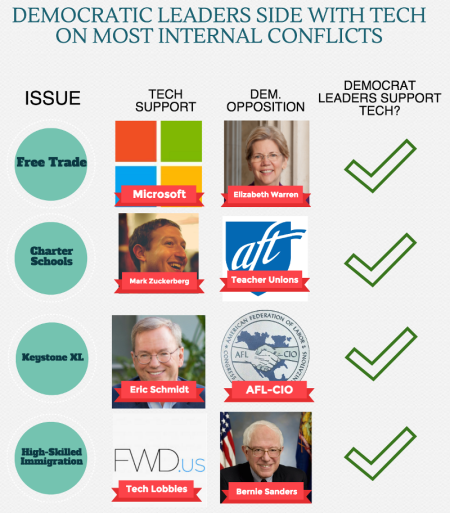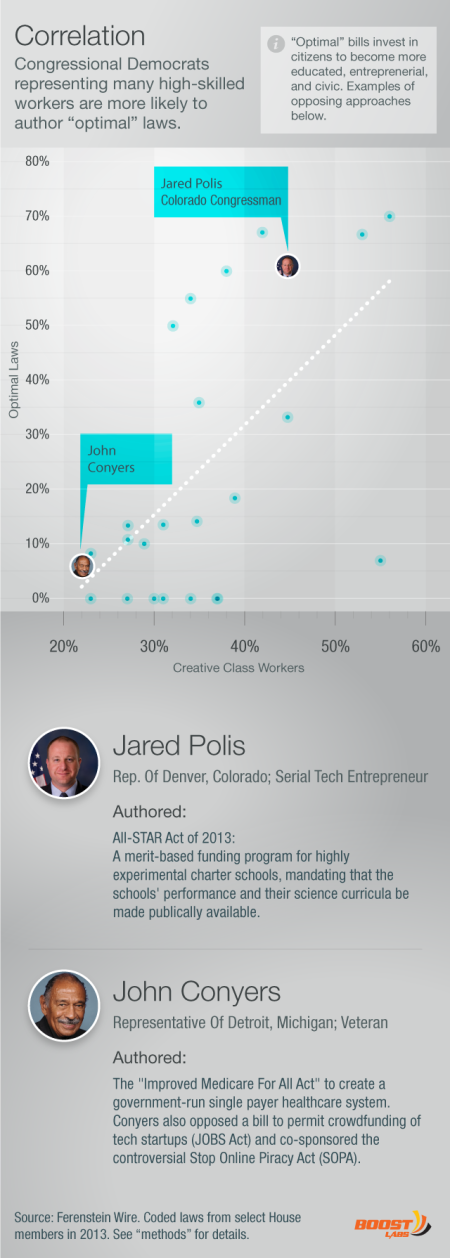The kinds of Democrats who go to college, get an entrepreneurial career or move to a big city — those who embrace a relatively unpredictable life — want an entirely different role for the federal government: they want the state to invest in modernization, with more high-skilled immigration, expansive free trade agreements, and performance-based charter schools.
Source: The Ferenstein Wire.
Startup founders and college-educated liberals fundamentally reject an atomistic conception of Society: government should be involved in personal decisions, such as finishing school or eating healthy, because they believe that personal decisions ripple out and significantly affect most people in Society.
Source: The Ferenstein Wire
Economically, the technology industry exacerbates inequality between the rich and middle-class, but eradicates poverty by making essential goods freely accessible. Ultimately, this will trend toward a two-class society of extremely wealthy workaholics who create technologies that allow the rest of society to enjoy leisurely prosperity. The cost for this prosperity will be inequality of influence
Source: The Ferenstein Wire.
A San Francisco journalist named Gary Ferenstein says the Democratic Party is no longer the party of factory workers and organized labor. It is the party of college-educated professionals and high-tech companies, he says, and this is a good thing.
He has published a manifesto on behalf of the Silicon Valley Democrats—which include Barack Obama and Hillary Clinton—and against “protectocrats” such as Bernie Sanders and Elizabeth Warren.
While not all Silicon Valley entrepreneurs and professionals think alike, any more than labor union members, white people or any other large category of people do, I think that Ferenstein does speak for many people from that background, and that his ideas are worth discussing.
His basic idea is that the government should give free rein to creative entrepreneurs, while trying to change individual behavior so as to make people more productive. The high-tech start-up corporation is his model for all the institutions of society.
Unlike the typical neo-liberal, he does not advocate allowing people to fend for themselves. Government should assure everyone an adequate education, adequate medical care and everything else they need to be economically productive.
He believes that the key to better education and better public health services is internal competition. He therefore favors Obamacare over a universal single-payer system, and charter schools over universal public education.
This is a form of radicalism that has appeared time and again in modern history—a radicalism that would revolutionize the way people live, yet leave the structure of political and economic power unchanged.
Ferenstein asserts that change is always good, there are no fundamental conflicts in society and education is the solution to all problems. Nobody struggling to survive in today’s harsh economy would believe any such thing, but I’m sure that there is a constituency that does.
He deserves credit for making that constituency’s assumptions explicit, and showing how they influence the Democratic Party leadership.
What follows is more of Ferenstein’s Silicon Valley manifesto, my comments and links to the full text of his writings.
What’s striking about this chart is that the right column consists of elected politicians and membership organizations which are accountable to a public, while the left column consists of corporate spokesmen who represent only their own interests. Ferenstein’s manifesto says nothing about democracy as a value.
Ferenstein opposes “protectocratic” programs primarily aimed at helping the disadvantaged, providing job security or otherwise buffering people against social and economic change. In his view, government should aim at optimizing the productivity of individuals.
Ferenstein also is critical of libertarians and neo-conservatives. What’s interesting about this chart is that has no square for social conservatism, which is the defense of tradition, community, religion and nation. Rejection of social conservatism is one reason Silicon Valley leaders have embraced the Democratic Party.
In my opinion, Silicon Valley’s support for gay rights, abortion rights and ethnic diversity is not based on respect for individual rights. It reflects a neo-liberal indifference to any characteristic of human beings except their productivity as workers and their spending power as consumers.
Some of this needs to be decoded.
- “Almost all change good over the long run” only applies to changes initiated by high tech companies.
- “No conflicts among major groups” means that there is no need for labor unions or consumer advocates.
- “Education can solve all or most problems in society” means that there is no need to consider changes in the tax structure, higher minimum wage, reform of corporate governance or breaking up monopolies.
- “Prioritizing international agreements over national sovereignty” means support for the North American Free Trade Agreement and the pending Trans Pacific Partnership Agreement. What these agreements do is to penalize national governments for enacting laws that limit corporate profits and create arbitration panels that are unaccountable to the public.
Two important topics that Ferenstein’s manifesto does not cover are military intervention and civil liberties. Given the dependence of the Pentagon and the NSA on Silicon Valley technology, these are glaring omissions.
I give successful founders of high tech companies credit for what they’ve accomplished, and I don’t think that everything they advocate is necessarily wrong. But I don’t think their accomplishments translate into political wisdom or a mandate to rule over the rest of us.
LINKS
I quizzed dozens of Silicon Valley elites about inequality. Here’s what they told me by Gregory Ferenstein for Vox.
How Silicon Valley is overhauling the Democratic Party by Greg Ferenstein for Business Insider.
What the Democratic party will look like when Silicon Valley takes over by Greg Ferenstein for the Ferenstein Wire.
Silicon Valley’s Political Endgame, Summarized by Greg Ferenstein for the Ferenstein Wire.
What Silicon Valley Really Thinks About Politics, an Attempted Measurement by Greg Ferenstein for the Ferenstein Wire.
How Silicon Valley Made Big-City Housing the Cause of and Solution to Inequality by Greg Ferenstein for the Ferenstein Wire.
The Birth and Death of Privacy: 3,000 Years of History Told Through 46 Images by Greg Ferenstein for the Ferenstein Wire.
Tags: Democrats, Greg Ferenstein, Silicon Valley, Tech Founders, The Ferenstein Wire









January 28, 2016 at 5:57 am |
[…] Ebersole, a blogger I follow who writes about political and social issues, wrote an interesting piece about the tech industry’s political agenda. As a libertarian and an individualist, I found some of these revelations really alarming. […]
LikeLike